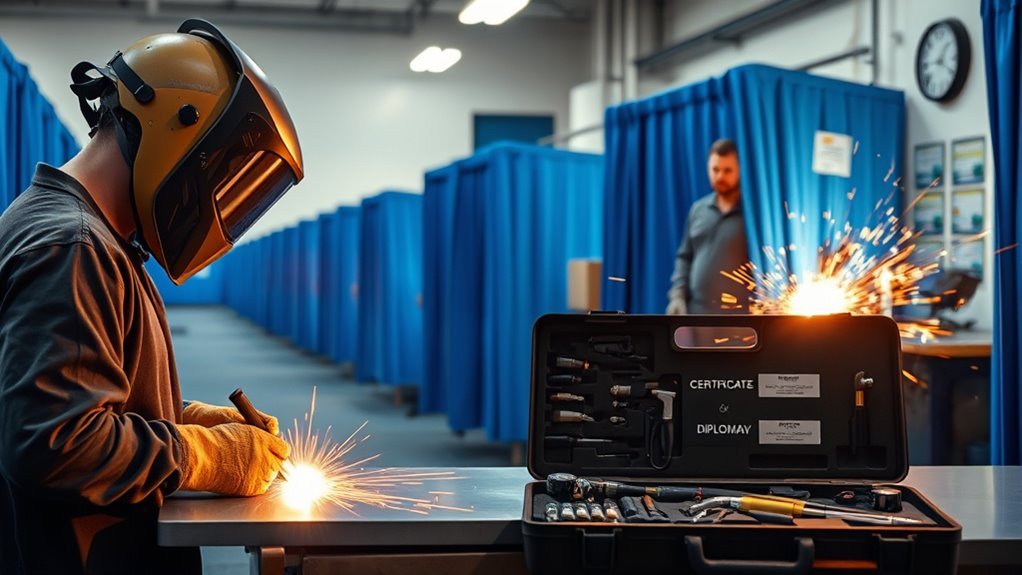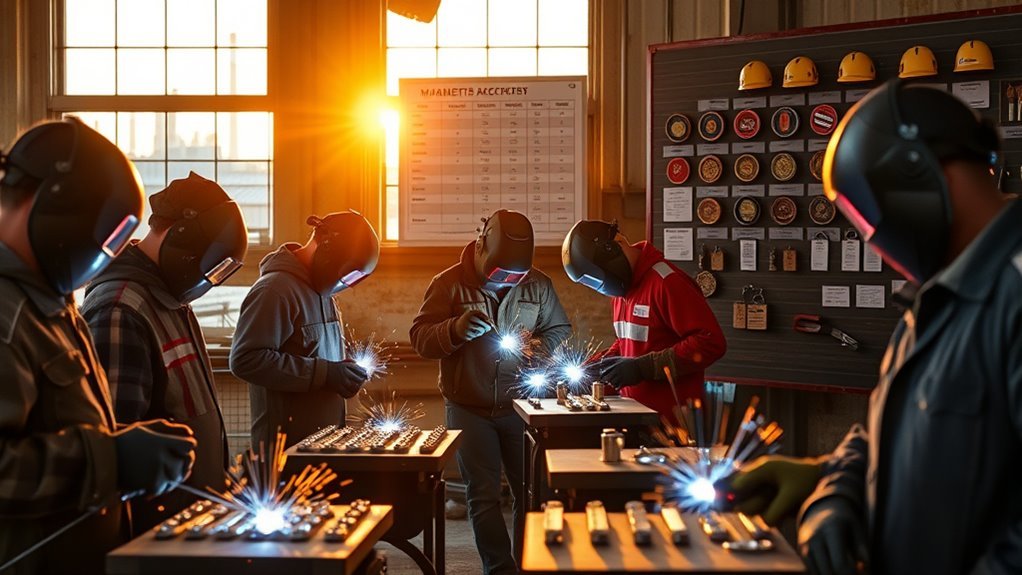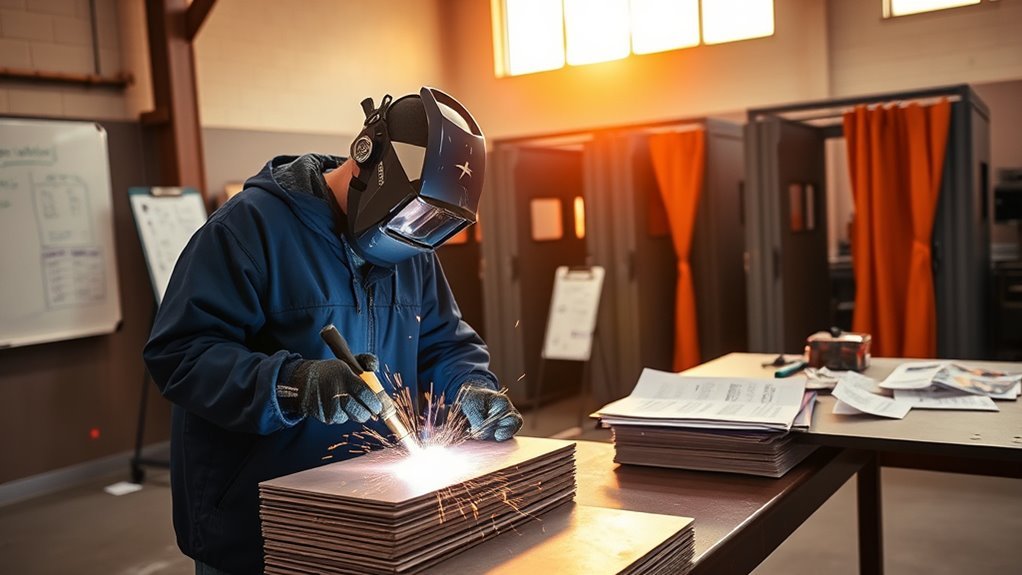Welding school in Minnesota will typically cost you about $4,400 for a one‑semester certificate or roughly $8,900 for a two‑semester diploma, not counting books, fees, tools, or living expenses. Expect additional first‑year costs like $725 for books, $1,924 in course fees, and a tools/uniforms budget around $235–$1,300. You can use FAFSA, Pell Grants, state scholarships, loans, or veteran benefits to lower out‑of‑pocket costs, and the next section explains program choices, aid, and budgeting.
Breakdown of Tuition, Fees, and Supplies

Because program length and course format affect your outlay, expect tuition to form the bulk of your welding-school costs: a typical Welding Diploma runs about $4,439 per semester for two semesters (roughly $8,878 total), while a one-semester Welding Certificate is about $4,439 and a focused GMAW Certificate comes in near $2,497.
You’ll want a clear tuition breakdown to compare options quickly. Add roughly $725 for books, $1,924 for course fees, and about $235 for tools and uniforms during your first year.
Supply costs can shift totals depending on whether you buy new gear or use school-provided items. Track mandatory fees, materials lists, and registration format to avoid unexpected charges and plan funding accordingly.
Program Options and Lengths (Certificate, Diploma, GMAW)

When you’re choosing a welding path, think about how much time you can commit and the skills you want to leave school with:
the diploma runs two semesters (32 credits) and focuses broadly on welding techniques, processes, and safety for about $4,439 per semester.
The one-semester certificate (16 credits) gives entry-level welding techniques and blueprint reading for roughly $4,439, letting you enter the workforce quickly.
If you want a very focused option, the GMAW certificate is one semester (9 credits) at about $2,497, specializing in Gas Metal Arc Welding.
All programs emphasize hands-on training for immediate employment or further study.
Use program comparisons to weigh cost, length, and skill depth before you enroll; first-year totals average near $6,658.20 (excludes tools/uniforms).
Financial Aid, Scholarships, and Veteran Benefits

If you need help covering tuition and fees, federal aid, state scholarships, school-specific awards, and veteran benefits can greatly reduce your out‑of‑pocket cost for welding programs in Minnesota.
Start with the FAFSA to see federal financial aid options: Pell Grants can provide up to $7,395 and Stafford Loans range roughly $5,500–$10,500.
Apply early for college scholarships — many open in fall and spring — so you can secure school-specific awards that don’t need repayment.
Check Minnesota’s Workforce Development Scholarship (about $2,500) and external scholarship opportunities like AWS awards to lower expenses further.
If you’re a veteran, contact the VA to verify eligibility for education benefits that may cover tuition and fees.
Career Paths and Potential Earnings in Minnesota

With financial aid and scholarships in place, you can focus on the career options that make the most sense for your goals and earnings needs.
In Minnesota, welders earn a median of about $27.54 per hour, with top pay near $34.94, so choosing a path affects your income.
Entry-level roles like Construction Welder or Manufacturing Welder often need a certificate or diploma you can earn quickly; welding certifications boost hireability.
Specialized tracks — Pipe Welder, Sheet Metal Worker, Welding Inspector — demand more training but can raise pay.
Strong industry demand means steady openings and room to advance as you gain experience.
Plan your training to match the role you want and the earnings you need.
How to Budget for Tools, Books, and Living Expenses

Because upfront costs can hit your budget quickly, you should plan precisely for books, tools, course fees, and living costs before you enroll in a welding program.
Expect about $725 for first-year books and roughly $1,924 in course fees, plus $235 for small supplies and leases. Factor in a full tools kit around $1,297.69 and additional tools, uniforms, and laptop needs.
Add living expenses based on your location and lifestyle. Use budget planning to total these amounts, then compare to available aid: Federal Pell Grants, scholarships, and school payment plans can reduce out‑of‑pocket spending.
Don’t forget ongoing tool maintenance costs and replacement. Track expenses monthly, prioritize essential purchases, and buy used or community-shared tools when practical to stretch funds.
Frequently Asked Questions
What Safety Certifications Are Required During Welding Training?
You need welding safety basics: OSHA-compliant training, respirator fit testing, and hot work/lockout-tagout. Certification requirements often include AWS SENSE or AWS D1.1 qualifications and employer-specific safety certificates you’ll complete during training.
Can I Transfer Credits Between Minnesota Welding Schools?
Yes — you can often transfer credits between Minnesota welding schools, but it depends on each school’s credit transfer policies. Check school policies, confirm course equivalencies, get approvals in writing, and be ready for possible evaluation or limits.
Do Schools Offer Evening or Weekend Welding Classes?
Like a steady metronome, you’ll find many schools offering evening classes and weekend courses to fit your schedule, and they’ll walk you through options, costs, and hands-on hours so you can plan practical training that works.
Is Job Placement Assistance Provided After Program Completion?
Yes — many programs offer job placement assistance after you finish; they’ll connect you with job opportunities, provide career support like resume help, interview prep, employer introductions, and follow-up to boost your chances of getting hired.
Are Apprenticeships Coordinated Through the Welding School?
Yes — many schools coordinate apprenticeships, and you’ll soon see why: they connect you to industry partnerships that open up apprenticeship benefits like paid training, mentorship, and job placement, so you’ll shift smoothly into skilled, paid work.
Conclusion
You’ve got a clear path: welding school in Minnesota usually means paying tuition, buying tools and supplies, and choosing between short certificates or longer diplomas like GMAW — but it’s affordable with aid, scholarships, and veteran benefits. Picture your future paycheck as a bridge you’ll build: plan for upfront costs, seek funding, and schedule honest budgets for living expenses. Stay practical, stay persistent, and you’ll weld your way into steady work and good earnings.


